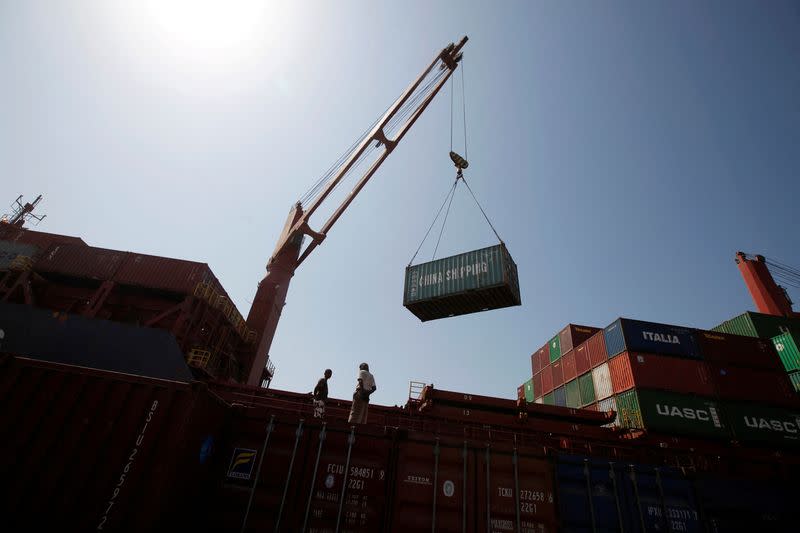Global inflation pressure is at risk of surging again as ongoing Houthi attacks on the Red Sea and traders looking to get ahead of new US tariffs on Chinese imports choke up Asian ports.
Congestion across Asian ports have hit levels not seen since the Covid-19 pandemic.
Ships with a total capacity of over 2.4 million twenty-foot equivalent container units (TEUs) were waiting at anchorages as of mid-June, with 60% of ships waiting at anchor located in Asia, maritime data firm Linerlytica said this month.
Among the worst hit Asian ports was Singapore — the world’s second-largest container port.
Also on AF: Canada Mulls Import Tariffs on Chinese EVs as Pressure Builds
The average wait time to berth a container ship was two to three days, Singapore’s Maritime and Port Authority (MPA) said in end-May. Container trackers Linerlytica and PortCast said delays could last up to a week.
Typically, berthing should take less than a day.
The primary cause of the worsening congestion remains ongoing Houthi aggression in the Red Sea which is forcing vessels to take longer routes around Africa.
The longer journey has disrupted ship timetables with missed sailing schedules and fewer port calls. Ships are, therefore, offloading larger amounts at once at big transhipment hubs like Singapore and forgoing subsequent voyages to catch up on schedules.
Transhipment hubs are ports where cargoes are unloaded and reloaded on different ships for the final leg of their journey.
“Liners have been accumulating boxes in Singapore and other hubs,” Jayendu Krishna, deputy head of Singapore-based consultancy Drewry Maritime Advisors, said.
Average Singapore cargo offload volume jumped 22% between January and May, according to the firm.
Drewry expects congestion at major transhipment ports to remain high, but anticipates some easing as carriers add capacity and restore schedules.
US tariffs on China in play
With some ships skipping Singapore to avoid congestion, neighbouring ports are backing up as well.
The strain has shifted to Malaysia’s Port Klang and Tanjung Pelepas, and wait times have also climbed at Chinese ports, with Shanghai and Qingdao seeing the longest delays.
Maersk, the world’s second-largest container carrier, said this month it would skip two westbound sailings from China and South Korea in early July due to severe congestion in Asian and Mediterranean ports.
Some industry players think part of the reason for the bottlenecks at China ports is fuelled by US importers rushing to buy Chinese goods such as steel and medical products that will be subject to steep tariff hikes from August 1.
But newly imposed US tariffs would affect only about 4% of Chinese imports to the US, said Jared Bernstein, chair of the Council of Economic Advisers.
Gene Seroka, executive director of the Port of Los Angeles, the largest US gateway for Chinese ocean imports, also expects a limited impact.
“We may see some of this cargo come in, but it is not going to be a deluge,” he said.
Peak season hits early
Congestion has also been exacerbated by the annual peak shipping season, which has arrived earlier than expected, shippers and research firms said.
This seems to be driven by restocking activities, particularly in the US, and by customers shipping goods early in anticipation of stronger demand, said Niki Frank, CEO of DHL Global Forwarding Asia Pacific.
Container import volume at the 10 largest US seaports in May rose 12%, fuelled by the second-highest monthly import volumes since January 2023, said data provider Descartes.
“(US) consumers are continuing to spend more than last year, and retailers are stocking up to meet demand,” said Jonathan Gold, a National Retail Federation vice president.
Concerns about the new tariffs on China and possible strikes at US ports this year could also be pulling the peak season forward, while DHL said German port strikes were adding to the gridlock.
Ocean imports into Europe from Asia are also showing signs of a re-stocking season running into peak season, Judah Levine of freight platform Freightos said.
Brace for more inflation
All of those disruptions mean global buyers face the risk of another spate of price increases like the post-pandemic inflation spike which central banks are still trying to tame.
Container freight prices from Asia to the US and Europe have tripled since early 2024.
Rates had stabilised into April but in May “there was a significant increase in ocean freight exports of Chinese e-commerce, electric vehicles, and renewable energy-related goods,” Asia-focussed freight forwarder Dimerco said.
Rates from Asia and Singapore to the US East Coast are at their highest since September 2022, while rates into the US West Coast are highest since August 2022, freight platform Xeneta said.
“These are huge financial hits for shippers to absorb,” chief analyst at Xeneta Peter Sand said.
- Reuters, with additional editing by Vishakha Saxena
Also read:
Shipping Chaos Set to be ‘New Normal’ Amid War, Climate Change
Global Trade Shrinks on Red Sea Woes But China Bucks the Trend
Red Sea Attacks Pose Billions Worth of Risks for China, India
Risk of ‘Environmental Catastrophe’ from Ship Sunk in Red Sea
Red Sea Crisis Hurting Indian Exporters As Rivals Nab Business
Shipping Firm to Use Saudi Land Routes to Avoid Red Sea Threat
Singapore-Bound Oil Tanker Hit as Red Sea Tensions Escalate
Red Sea Attacks Spur a Surge in Asia-to-Europe Air Freight
Panama Canal Traffic Cut by Third, Adds to Red Sea Woes – AP
Chinese Exporters Face Shipping Crisis From Red Sea Attacks
























